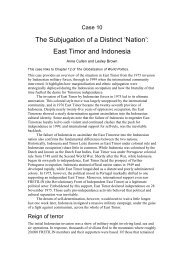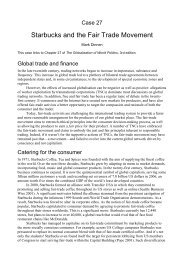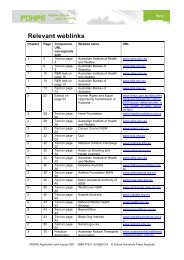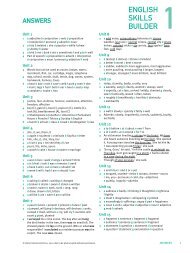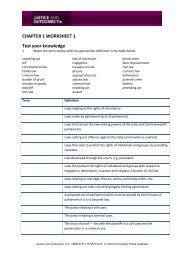2 Chapter 6 ⢠organising elements Organising elements
2 Chapter 6 ⢠organising elements Organising elements
2 Chapter 6 ⢠organising elements Organising elements
You also want an ePaper? Increase the reach of your titles
YUMPU automatically turns print PDFs into web optimized ePapers that Google loves.
SKILLS LAB<br />
24<br />
Ionic compounds<br />
Ionic compounds are those formed from the bonding of ions. Let’s<br />
consider sodium chloride, which is produced when sodium and<br />
chlorine meet and react. In this compound, the metal sodium is<br />
present in the form of positively charged ions (Na + ) and the non-metal<br />
chlorine is present as negatively charged ions (Cl – ). Notice that the:<br />
• metal is named first and its name is not changed<br />
• non-metal is named second and the end of its name is changed<br />
from -ine to -ide<br />
This follows a standard naming convention, as follows.<br />
• The positively charged ion (cation) in the compound is written<br />
first and keeps the name of the metal from which it was formed.<br />
• The negatively charged ion (anion) in the compound is written<br />
second. Replace the end of the name of the non-metal from<br />
which it formed with -ide.<br />
• Some transition metals can form more than one ion. In these<br />
cases, a Roman numeral is used to show the charge on the ion.<br />
For example, copper forms two ions: one with a 1+ charge<br />
and one with a 2+ charge. These ions are called copper (I) and<br />
copper (II) ions, respectively.<br />
The properties of ionic<br />
compounds<br />
Compounds that are held together by ionic bonds are<br />
called ionic compounds. As an ionic compound forms,<br />
the like charged ions repel each other and the oppositely<br />
charged ions attract each other. After all the pushing<br />
and pulling, the ions settle into alternating positions,<br />
as shown in Figure 6.32, because this is the most stable<br />
arrangement. The particles are held together by strong<br />
electrostatic forces of attraction between the positively<br />
charged ions. Because these forces bind the ions together,<br />
this is known as ionic bonding.<br />
A lot of energy is required to move the ions out of their<br />
positions because the electrostatic forces are so strong.<br />
This means that ionic compounds are hard to melt. At<br />
room temperature, they are in the form of hard, brittle<br />
crystals. The most commonly known example of an<br />
ionic compound is sodium chloride (table salt). Its<br />
melting point is 801°C. If you use a salt grinder at home,<br />
you will be aware of how hard and brittle salt crystals<br />
are.<br />
<strong>Chapter</strong> 6 • <strong>organising</strong> <strong>elements</strong><br />
The names and formulas of some common<br />
examples of some ions are listed in Table 6.5.<br />
Table 6.5<br />
Formulas of some common ions<br />
Cations<br />
Anions<br />
Name Formula Name Formula<br />
Lithium Li + Fluoride F −<br />
Sodium Na + Chloride Cl −<br />
Potassium K + Bromide Br −<br />
Magnesium Mg 2+ Iodide I −<br />
Calcium Ca 2+ Oxide O 2−<br />
Aluminium Al 3+ Sulfide S 2−<br />
Silver Ag + Nitride N 3−<br />
Zinc Zn 2+<br />
Copper (II) Cu 2+<br />
Iron (II) Fe 2+<br />
Iron (III) Fe 3+<br />
Polyatomic ions<br />
A number of ions are made up of more than one atom.<br />
These are termed polyatomic ions. Figure 6.33 shows<br />
some examples of polyatomic ions.<br />
These clusters of atoms have a charge because the total<br />
number of protons does not equal the total number of<br />
electrons present. For example, in the hydroxide ion,<br />
which is made up of two atoms (one each of oxygen<br />
and hydrogen), there are nine protons and ten electrons.<br />
This means the ion has an overall charge of 1–.<br />
Calcium carbonate, the main constituent of marble,<br />
is an example of an ionic compound that contains a<br />
polyatomic ion. Calcium carbonate contains calcium<br />
2–<br />
ions, Ca 2+ , and carbonate ions, CO 3 . These ions must be<br />
present in the ratio 1:1 so that the total positive charge<br />
equals the total negative charge. The formula of calcium<br />
carbonate is CaCO 3 . Ammonium carbonate is used in<br />
smelling salts. It contains ammonium ions, NH 4+ , and<br />
2–<br />
carbonate ions, CO 3 . In this case, the ions need to be<br />
present in the ratio 2:1. The formula of ammonium<br />
carbonate is (NH 4 )2CO 3 .<br />
UNCORRECTED PAGE PROOFS<br />
CAS_SB10_TXT_06_1pp.indd 24<br />
11/11/11 4:58 PM






